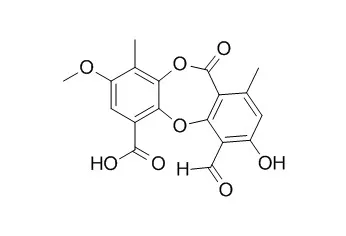| In vitro: |
| Pharmaceutical Biology, 2012, 50(8):968-979. | | Antioxidative and cardiovascular-protective activities of metabolite usnic acid and psoromic acid produced by lichen species Usnea complanata under submerged fermentation.[Reference: WebLink] | Lichens have been used for various purposes such as dyes, perfumes and remedies in folk medicine indicating the pharmaceutical potential of lichens. Lichen growth in nature is very slow. To overcome this major drawback, we standardized the culture media to culture the lichen Usnea complanata (Müll.Arg.) Motyka (Parmeliaceae) for (1) in vitro synthesis of natural lichen substances, and (2) determination of antioxidative and cardiovascular-protective activity of usnic acid and Psoromic acid.
METHODS AND RESULTS:
Lichen U. complanata has been cultured in fermentor under submerged condition. Antioxidative and cardiovascular-protective activity of the extract and the purified lichen substances usnic and Psoromic acid have been determined. Except methanol, all other extracts exhibited antioxidative action in terms of free radical scavenging activity (FRSA) with a half-inhibiting concentration (IC₅₀) value of 22.86 to 25.0 µg/mL, nitric oxide radical scavenging activity (NORSA) 141.3 to 149.1 µg/mL and for lipid peroxidation inhibition (LPI) 125 to 157.9 µg/mL. Usnic acid or Psoromic acid showed antioxidative action with IC₅₀ values ranging from 0.174 to 0.271 mg/mL. Methanol and ethyl acetate extract showed hydroxy-3-methyl-glutaryl-CoA reductase (HMGR) inhibition of 65.18 to 74.81%. Only 43.47% inhibition of angiotensin converting enzyme (ACE) was shown by methanol extract. Usnic acid showed noncompetitive type of HMGR inhibition and uncompetitive type of ACE inhibition. Psoromic acid exhibited competitive type of HMGR inhibition and mixed type of ACE inhibition.
CONCLUSIONS:
U. complanata showed both cardiovascular-protective and antioxidant properties. The lichen species U. complanata may be a natural bioresource for possible pharmaceutical applications. | | Journal of Clinical Medicine, 2018, 7(8):226. | | Antimycobacterial, Enzyme Inhibition, and Molecular Interaction Studies of Psoromic Acid in Mycobacterium tuberculosis: Efficacy and Safety Investigations.[Reference: WebLink] | The current study explores the antimycobacterial efficacy of lichen-derived Psoromic acid (PA) against clinical strains of Mycobacterium tuberculosis (M.tb). Additionally, the inhibitory efficacy of PA against two critical enzymes associated with M.tb, namely, UDP-galactopyranose mutase (UGM) and arylamine-N-acetyltransferase (TBNAT), as drug targets for antituberculosis therapy were determined.
METHODS AND RESULTS:
PA showed a profound inhibitory effect towards all the M.tb strains tested, with minimum inhibitory concentrations (MICs) ranging between 3.2 and 4.1 µM, and selectivity indices (SIs) ranging between 18.3 and 23.4. On the other hand, the standard drug isoniazid (INH) displayed comparably high MIC values (varying from 5.4 to 5.8 µM) as well as low SI values (13.0–13.9). Interestingly, PA did not exhibit any cytotoxic effects on a human liver hepatocellular carcinoma cell line even at the highest concentration tested (75 µM). PA demonstrated remarkable suppressing propensity against UGM compared to standard uridine-5'-diphosphate (UDP), with 85.8 and 99.3% of inhibition, respectively. In addition, PA also exerted phenomenal inhibitory efficacy (half maximal inhibitory concentration (IC50) value = 8.7 µM, and 77.4% inhibition) against TBNAT compared with standard INH (IC50 value = 6.2 µM and 96.3% inhibition).
CONCLUSIONS:
Furthermore, in silico analysis validated the outcomes of in vitro assays, as the molecular interactions of PA with the active sites of UGM and TBNAT were unveiled using molecular docking and structure–activity relationship studies. Concomitantly, our findings present PA as an effective and safe natural drug plausible for use in controlling tuberculosis infections. | | Fitoterapia, 2017, 121:164-169. | | Antibacterial activities of natural lichen compounds against Streptococcus gordonii and Porphyromonas gingivalis.[Reference: WebLink] | The oral bacteria not only infect the mouth and reside there, but also travel through the blood and reach distant body organs. If left untreated, the dental biofilm that can cause destructive inflammation in the oral cavity may result in serious medical complications. In dental biofilm, Streptococcus gordonii, a primary oral colonizer, constitutes the platform on which late pathogenic colonizers like Porphyromonas gingivalis, the causative agent of periodontal diseases, will bind. The aim of this study was to determine the antibacterial activity of eleven natural lichen compounds belonging to different chemical families and spanning from linear into cyclic and aromatic structures to uncover new antibiotics which can fight against the oral bacteria.
METHODS AND RESULTS:
The compounds were screened by broth microdilution assay. Three compounds were shown to have promising antibacterial activities where the depsidone core with certain functional groups constituted the best compound, Psoromic acid, with the lowest MICs=11.72 and 5.86μg/mL against S. gordonii and P. gingivalis, respectively.
CONCLUSIONS:
The compounds screened had promising antibacterial activity which might be attributed to some important functional groups as discussed in our study. The best compounds did not induce the death of gingival epithelial carcinoma cells (Ca9-22). These results introduce new compounds having potent antibacterial activities against oral pathogens causing serious medical complications. |
|






 Cell. 2018 Jan 11;172(1-2):249-261.e12. doi: 10.1016/j.cell.2017.12.019.IF=36.216(2019)
Cell. 2018 Jan 11;172(1-2):249-261.e12. doi: 10.1016/j.cell.2017.12.019.IF=36.216(2019) Cell Metab. 2020 Mar 3;31(3):534-548.e5. doi: 10.1016/j.cmet.2020.01.002.IF=22.415(2019)
Cell Metab. 2020 Mar 3;31(3):534-548.e5. doi: 10.1016/j.cmet.2020.01.002.IF=22.415(2019) Mol Cell. 2017 Nov 16;68(4):673-685.e6. doi: 10.1016/j.molcel.2017.10.022.IF=14.548(2019)
Mol Cell. 2017 Nov 16;68(4):673-685.e6. doi: 10.1016/j.molcel.2017.10.022.IF=14.548(2019)